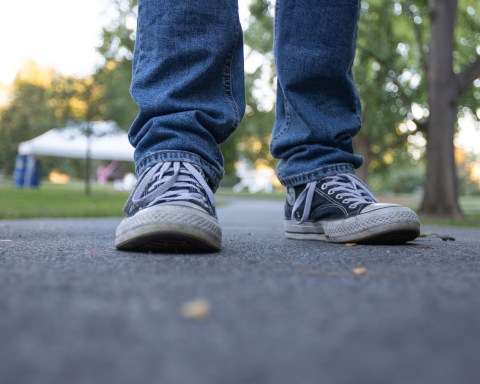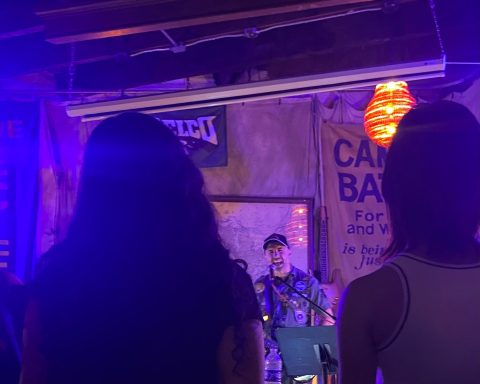Editor’s note: This article was initially published in The Daily Gazette, Swarthmore’s online, daily newspaper founded in Fall 1996. As of Fall 2018, the DG has merged with The Phoenix. See the about page to read more about the DG.
This is the second installment of “The Fountain Pen,” a column dedicated to documenting and exploring our campus’ water fountains and the people who use them.
The scientifically inclined among us know that Paces parties aren’t the only things that have dried up recently. In the past few months, Cornell’s second floor, and by extension the entire library, has, for all intents and purposes, become a water-fountain desert.
It wasn’t always like this. As recently as September 2014, a fully functional water fountain stood tall near the entrance to the second-floor study hall. Located right next to a bathroom, it imparted on the room the rare gift of the closed cycle: the water we took from the Earth, we could give back to the Earth, all in the same place.
A few months ago, this utopia of convenience, quietly and without much fanfare, came to an abrupt end. The fountain still stands, but it stands meekly – defunct and incapacitated. To those who look, it announces its death sentence in paper form: “We need a new water fountain,” dated October 10, 2014.
(Image courtesy of Eduard Saakashvili.)
The nearest working water fountain is now next to the Science Center coffee bar, at least two doors and a hefty walk away. The convenience of old has all but disappeared.
I remember the Cornell 2nd fountain in its prime. I could spend hours upon hours holed up in a carrel, feeling as if I would never have to leave. And indeed, whenever the treacherous impulse of thirst reared its compelling head, I could quench it with a short walk over Cornell’s soft carpet. That carpet, with its pleasantly rubbery elasticity, would carry me, as if by propulsive floatation, to and from my watery target. Even when I was not at the fountain, partaking in the water’s parabolic dance with gravity, I could inhale its trace vapors, and they would impart the comforting reassurance that the elusive peace of hydration was just a few small steps away.
But though these memories are as persistent as they are cherished, there are things I have forgotten.
I have forgotten the sound the fountain’s plumbing made as the water raced up to be spewed into the air. I have forgotten the length of the wait between the pressing of the button and the emergence of the stream. But most tragically and unforgivably, I have forgotten the taste.
Now, do not misunderstand me, for water still flows on Cornell second. It flows in the bathroom’s sinks and toilets, and it flows in the black water dispenser that stands next to the broken fountain. If you have a bottle, you can still get water. But the playing field has been tilted, and immediate hydration, formerly accessible to all, has become a luxury of the few. Those few are the owners and wielders of water bottles, and they have claimed Cornell 2nd as their own.
One of them is Tyler Alexander ‘17, who carried his water bottle with him wherever he goes. Unsurprisingly, the water fountain’s demise has not affected him. He acknowledges, however, that things might be very different if he didn’t own a water bottle.
“Maybe if I didn’t have a water bottle I’d hang around in the Science Center Commons, just to be close to a working water fountain,” he said.
For many of us, however, this is not a hypothetical scenario, but a daily reality.
One of those affected is Chris You ‘17, who often goes to Cornell 2nd for its peace and quiet. The absence of a working fountain has dramatically impacted his Cornell experience.
“If you don’t have a water bottle, you have to walk all the way out, and drink from the shitty water fountain next to Sci 101. And I only do that when I’m desperate, really. Otherwise I just don’t drink water,” Chris said.
To Chris, a bottleless student, the bottle-friendly dispenser’s dark void might as well not be there. The horror of his dehydrated predicament is surpassed only by the fact that his experience is shared by dozens, if not hundreds, of other Swatties.
And it goes on.
As long as the defunct water fountain remains on a seemingly endless, Kafkaesque death row, Cornell 2nd will continue to be a hostile space to those who prefer to get their water from a kinetic, spritely stream instead of the cynically cylindrical confines of a bottle. As long as the College continues to ignore the selective draught its inaction perpetrates against the bottleless masses, Cornell will, to many of us, remain a dry zone.
Only through remembering can we access the library we once knew, where water flowed freely and all could partake in its profusion. In the meantime, this former justice is nothing but a ghost.
For now, our weapons are hope and memory: Hope for a future where water is again available to all patrons of Cornell 2nd, and the memory that reminds us of that future’s possibility.
Featured image courtesy of Eduard Saakashvili.

















People without bottles complain too much. I worked hard and went out of my way to get a water bottle, and i think i deserve pure filtered water and just because some people are too lazy to get a bottle doesnt mean that we should give handouts like water fountains which dont need bottles to freeloaders.
would read again.
The title is absolutely killing me!
One thing I don’t understand even about myself is, why don’t people just drink tap water, if it is as safe and clean as rumored? Especially when they have such an acute need.
P.S. This way you can also control for the tempearture of the water so that, e.g. it won’t get too icy.